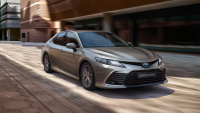If we are to believe the e-ticket entries, I travelled about 2,000 km on the flight to the Toyota Camry Hybrid presentation - all in order to find out just two figures: 0-100 km/h acceleration and fuel consumption. In fact, it is already known that Toyota's hybrid technology really works: it reduces consumption, adds dynamics. The only question is "how much". Plus, the last Toyota Camry review left a couple of questions, the key one being the question of the alternative engine. Can the Toyota Camry Hybrid surprise with its powertrain and character? Or maybe something else? You'll find all the answers below
Toyota Camry Hybrid - what is it?
In a nutshell: it is a mixture of Toyota Camry and hybrid technology of the new Toyota RAV4. The car is built on the TNGA platform (a version of the GA-K platform), which has made the body stiffer and lower, the novelty has a similar design outside and inside. The essence of external changes is in details: logos have got blue backing traditionally for hybrids of Toyota, "Hybrid" inscription on front wings, and exhaust pipe now is on the left side. Change of interior is only in trifles: at once, you notice original instrumentation, where the place of a tachometer is taken by a universal "power meter" with three working zones of the hybrid power unit - green eco-zone, white quarter of maximum capacity, and blue sector of energy recovery. Otherwise, everything else is the same - and that's a good thing: the interior is spacious, the seats are comfortable, the steering wheel is good in leather on the rim (though still simple in design), the climate and multimedia controls are instantly understandable.

Outside and inside, the Toyota Camry Hybrid has only changed in detail: logos, lettering, instrumentation. You may say I'm getting old, but it's good: you don't want to change nice look and comfortable interior. But under a cowl there are noticeably more changes...
The main thing in Toyota Camry Hybrid is, of course, the THS (Toyota Hybrid System) next-generation hybrid powertrain: the union of the petrol engine and the electric motor, which are combined through a complex planetary transmission. And each of the items is original and unique in its own way. The hybrid uses the A25A-FXS engine from the new Dynamic Force range, a 4-cylinder 2.5-litre diesel engine with an extremely high efficiency rating of 41% - the manufacturer claims to have the world's best efficiency rating for engines of this type. How did this happen? Firstly, the engine is designed for a very high compression ratio of 14:1, which boosts power output while cutting fuel consumption and emissions. Secondly, dual D-4S injection: Injection into the cylinders and intake manifold - each works better for different driving conditions. Third: VVT-iE (inlet, with electric drive) and VVT-i (outlet) variable valve timing systems are installed - also solutions to the economy. These are just the main features of the engine, but in addition there is also the tricky know-how of the company - for example, laser treatment of the seats of the intake valves, which allows you to remove eddies and improve the filling of the cylinders. Admittedly, the output of the petrol engine is not too great - 177 bhp at 5,700 rpm and 221 Nm at 3,600-5,200 rpm. - But something hints that the accent in the engine was made not on maximum capacity, but on economy of fuel...
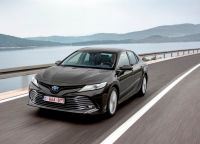
Especially, in case of maximum dynamic acceleration the electric motor will help: 88 kW or 120 hp and 202 Nm of torque already from the first turn of a rotor. Of course, we want to see almost 300 horsepower in total, but the truth is that the electric motor and the engine reach their maximum performance at different rpm, and therefore power and torque cannot be considered as a simple arithmetic addition of two numbers. The final result of the new Toyota Camry Hybrid is 218 bhp, but it's still more than its predecessors: earlier, it had 187-200 bhp depending on the generation. This power is enough to disperse 0-100 km / h for 8.3 seconds (which is 1.4 seconds faster than the usual version of Toyota Camry 2.5 liters), although the maximum speed of the hybrid is lower - 180 km / h.
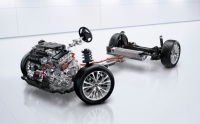
Incidentally, while in previous generations the hybrid's traction battery was installed in the boot, which somewhat reduced its volume, now the battery is located under the back seat and the boot remains the same: about 500 liters of usable volume - the exact figure depends on the car version and the presence/absence of rear seat backrests tilt. This decision required the Toyota Camry Hybrid's fuel tank to be reduced to 50 liters, but the hybrid's consumption is no problem: 4.4-5.2 liters per 100 km, depending on wheel size and city or highway travel. The traction battery operates at almost 245 volts and offers a capacity of 6.5 Ah: a total of about 1.6 kWh. Also, it's still made with NiMH technology. However, Toyota's strength is in the vast experience it has with such batteries - for example, one feature is that the battery operates in the 30-90% range of its rated capacity: it never "zeros out" and never "plugs in". As a result, this gentle mode of operation is a guarantee of health: the batteries in Toyota hybrids last a very long time - proven by older Prius drivers.

Hybrid version of Toyota Camry Hybrid is the firm technology THS (Toyota Hybrid System), but already in new generation: 2,5-liter 177-horsepower petrol engine, electric motor with 120 hp, plus planetary gear which connects them together (gear ratio of differential of main pair 3,389:1). It's not easy to identify the hybrid under the bonnet: only a pair of bright high-voltage wires barely showing from the driver's side will help. Suspension is independent all round: MacPherson in the front and double wishbone in the rear. Moving of the traction battery (245 volt, 6.5 Ah) under the back seat allowed to keep the same volume of the boot - 469 liters of useful space. Sophisticated technology means plus about 100 kg to the usual combustion engine version: the Toyota Camry Hybrid weighs 1670-1735 kg, depending on a complete set. However, the hybrid technique still allows increasing efficiency, improving dynamics, and reducing fuel consumption: capacity 218 hp, 0-100 km/h in 8,3 seconds, consumption 4,4-5,2 liters, maximum 180 km/h.
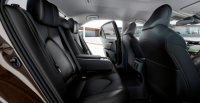
And how does it go? What's the real acceleration? What about fuel consumption?
In general, it rides like a conventional version of Toyota Camry: light, soft, pleasant ride, at the same time - the readiness to turn and maneuver. The lighter car still obeys the steering wheel well, carries out commands adequately and without delay, stands well in a straight line and is stable in turns. I have to confess that the roads were good everywhere during the test drive, so I can't say anything concrete about rigidity of the suspension. Still, I hope that Toyota Camry has not lost its softness: firstly, because it is Camry, and secondly, because a couple of found joints, potholes, patches were passed quite comfortably. But except for a suspension, Toyota Camry Hybrid turns out the comfortable car also from the point of view of sound. In fact, traditional internal combustion engine, sometimes, does not work at all or works at low-to-medium speeds - as a result, while driving in the cabin is very quiet, you can hear a distinct roar of the engine only when accelerating "gas to the floor".
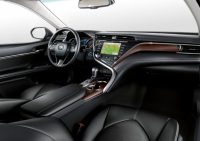
By the way, acceleration 0-100 km / h in style "gas in the floor" gives an average figure 8.6 seconds - up to the passport data did not managed quite a bit, but it is still noticeably better than the internal combustion engine version of Toyota Camry. For maximum dynamic acceleration it is necessary to switch on a sport mode "automatic" (why it is so in real absence of automatic transmission - it is not clear, but it is the fact) and a sport mode of driving settings. Yes, yes, the hybrid version of Toyota Camry has a function of choice of driving settings: ECO - maximum use of electric power and smooth acceleration, NORMAL - very balanced mode, SPORT - maximum power and dynamics, the engine is connected earlier than usual. In addition, a separate button EV Mode is provided, which switches the hybrid into electric car mode: driving is performed only by the electric motor.
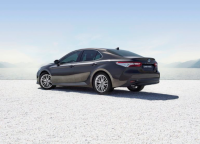
However, it is possible to drive this way not for a long time. The battery suffices only for 1-1,3 km even at smooth "pedaling" with an accelerator - it reminds a situation with driving in Toyota C-HR. Also the similar logic of acceleration control, to which it is necessary to get used to: when pressing an accelerator pedal you actually control not acceleration itself, but intensity of acceleration. The "power meter" arrow may be in the green or white zone, it may freeze in place - and the speed will increase to a certain mark: similar to driving a car with a variator or an electric car. But you get used to it quickly: unlike the aforementioned C-HR, the Camry Hybrid uses more powerful motors (both combustion and electric), while the car itself sets up for a calm, measured driving style - the result is a smooth and smooth ride. The same is with deceleration: when releasing accelerator pedal - small recuperation (a sort of "engine braking"), when pressing the brake pedal - braking mechanisms already start to work, plus the intensity of recuperation also grows up to the maximum.
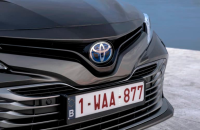
On the road, the hybrid paid off: acceleration from 0-100 km/h in 8.6 seconds and, at the same time, lower fuel consumption. Thus, the mixed consumption during the test drive came out 6.6 liters per 100 kilometers, while driving in the city and subsequent measurements of dynamics, the figure was about 8.5 liters per 100 kilometers, when driving on highways at speeds of 80-130 km/h consumption varies constantly at the mark 4.3-4.6 liters per 100 kilometers. Certainly, it is desirable to drive the automobile long time in Ukraine, to follow the expense on habitual routes, but it is already clear: the hybrid appears more economical than usual internal combustion engine version in 1,5-2,5 times depending on driving style and operating conditions. By the way, sometimes the electric motor pulls the hybrid on its own, even at speeds under 100 km/h. The new Toyota Camry Hybrid offered a button for choice of complex driving modes and a separate button EV Mode. But we must admit - these are all "toys": the most balanced driving mode is NORMAL, and the beginning of movement is always with the help of electric traction - it is possible to pull through a small "traffic jam" without pressing EV Mode.
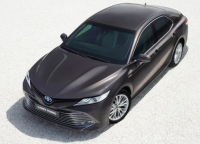
On the subject of hybrid technology and driving, it's clear. Has anything else changed?
Unexpectedly, but yes. Unexpectedly, because we've introduced a new type of powertrain, which solves a crucial issue for the Toyota Camry, and we've also got a number of additional driver assistance systems, which solve a number of secondary issues. Firstly, Toyota Camry Hybrid offered Blind Spot Monitoring (BSM): if the car detects an obstruction on the right/left, it activates a warning light in the appropriate rear-view mirror. The other is RCTB (Rear Cross Traffic Brake) when reversing: if the car detects an obstacle when reversing, it alerts the driver and brakes itself to avoid an accident. Both systems made their debut at the same time, as they are based on the same additional radar sensors mounted in the corners of the rear bumper.
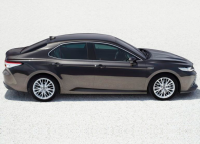
Apart from the safety assist systems, the new Toyota Camry Hybrid has also become more user-friendly in terms of minor details. There is a 10-inch HUD (Head Up Display) projection on the windscreen in front of the driver's eyes, speed information, navigation prompts and road sign reading system. There is also a scale for the engine operation, similar to the "power meter" described above. A small horizontal bar is projected in front of the driver's eyes, divided into three zones highlighted by their colour - green (eco-drive), white (maximum power), blue (regeneration). Finally, the hybrid has received a "Qi" wireless smartphone charging system, with a smartphone slot located in a recess near the automatic lever.
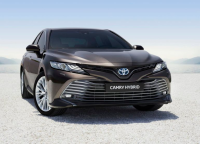
Little things, little things, but the Toyota Camry Hybrid scores extra points. Blind spot monitoring and cross-traffic control when reversing are for safety, the projection display and wireless charging in a recess near the automatic lever are for everyday usability.
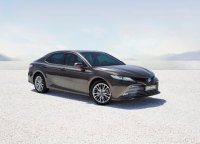

-rear-and-front-view-camera-6.png)
